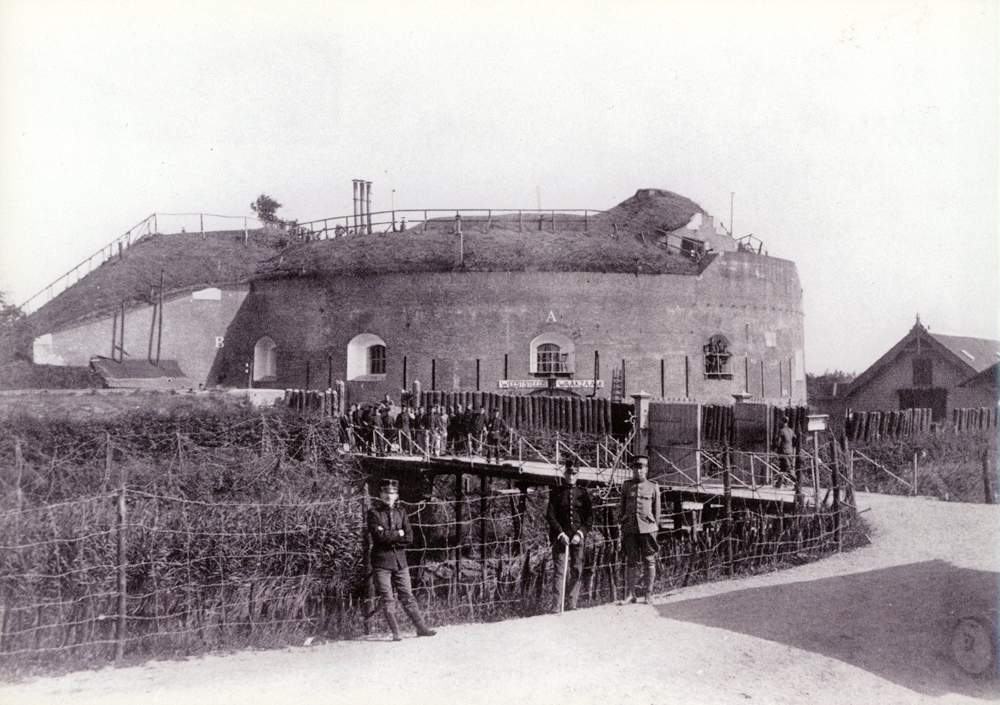Heritage between nature and culture
This temporary installation was developed for the exhibition ‘Retreat’, on invitation by Ben van Berkel and Caroline Bos, UNStudio.
The theme retreat makes me think in the first instance of people who withdraw from the world for a time in order to find themselves. A location such as Fort Asperen would be extremely suitable in this regard. So suitable in fact that any intervention on my part designed to intensify this feeling would be merely superfluous. You could simply shut a door behind you and no-one would find you as you eternally revolved around the pivot of your thoughts. An interesting image, but a visit to the fort suggested another subject connected with the theme.
location: Acquoy, Netherlands
dimension: 830 x 830 x 480 cm
material: recycled construction plywood, square timber, steel cables, tensioners
venue: KunstFort Asperen
exhibition: RETREAT, June 28 – September 20
curator: UNStudio, Ben van Berkel, Caroline Bos
manufacture: Studio Frank Havermans
install: Studio Frank Havermans + Stijn van der Vleuten
photography: © René de Wit, Breda
PUBLICATIONS

Fort Asperen tijdens de mobilisatie van 1915

a number of bat species hibernate in Fort Asperen
A number of species on our planet go into hibernation, an extreme form of retreat. Without a hint of spirituality, these animals withdraw for a number of months to inaccessible places. Well hidden from predators or people. This familiar fact becomes interesting when this natural need interfaces with our built environment. What are the choices then? At a place like Fort Asperen it is certainly an issue. A number of bat species hibernate here, including some rare ones. In a fort abandoned long ago when it lost its function, these small creatures of the night have found the perfect ‘cave’ in which to safely withdraw. But cultural interest in this kind of building has grown considerably in recent years.
In many places the forts and defences associated with the Nieuwe Hollandse Waterlinie have been restored and assigned another function. Leisure and tourism often play a prominent role in this respect. But this fort distinguishes itself rather thrillingly from the rest: not only has it acquired protected status as a listed building, it also provides temporary winter accommodation for protected species. Both these aspects of the fort are the result of our irrepressible urge to expand. Unusual, exceptional things have to be protected from this urge. Yet now changes have to come, precisely in this abandoned place, where past decades have produced a symbiosis between artefact and nature. It is an interesting dilemma. Fort or bats? Or both?
I simply have to accept the fact that these bats hibernate in the fort. I’ve never seen them hanging there, not even during a springtime visit. There are people who know where to find them, but it’s shrouded in secrecy.
KAPKAR/TFA-5W, the construction that took possession of the air shaft last winter, has a relationship with the fort of total dependency. It unexpectedly managed to make its way inside, through the slits in the temporary roof above this shaft and then lodged itself there. Five structural arms penetrated the upper windows of the fort and wedged themselves behind the window openings. In contrast with the modest space and inconspicuous location occupied by the bats, this construction selected a prominent spot. Something is obviously afoot.
The construction is mechanical but also has an animal quality. How did it get here, what is it doing here and will it ever go away again? If you assign this place another function, will fort and art live in harmony? This is a rare construction so it is only a matter of time before it is also accorded protected status. Then it will have the fort in its grip, literally and figuratively.


